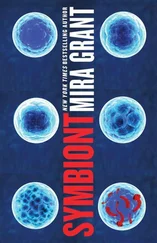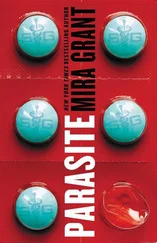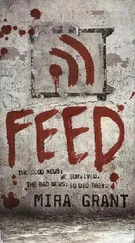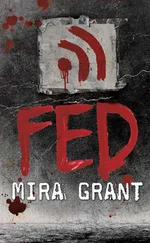“The Australian?” I asked.
Mahir nodded. “Precisely. I might not have been under surveillance before that, but the odds increased rather substantially after I got someone deported. That’s when I realized it might be best for everyone if I came here.”
“Makes sense.” I glanced toward Alaric and Becks, saying, “One of the scientists Mahir went to talk to about Dr. Abbey’s research got kicked out of the country.”
Alaric whistled, long and low. “That’s not fooling around.”
“No, it’s not,” said Mahir, with dry gravity. “What we have here is a combination of the material that was originally sent to me, the material provided by Doctors Tiwari and Christopher, some supplemental research I was able to request from Dr. Shoji of the Kauai Institute of Virology before I felt it was unsafe to make any further out-of-country contacts, and finally, the files I was able to retrieve from Professor Brannon’s mail drop before it was shut down. I don’t have copies for everyone, but there’s enough here to keep us all predicting the end of the world until well past dawn.”
“Who’s Professor Brannon?” asked Becks. “Because I’m feeling a bit like I missed a memo somewhere.”
“Professor Brannon…” Alaric frowned. “He was a world-renowned expert in the behavior of Kellis-Amberlee. He spent his entire professional career identifying and studying viral substrains. He…” Alaric’s eyes went wide. “He shot himself last week. It was a devastating blow to the epidemiological community. No one saw it coming.”
“I’m afraid that was my fault.” Mahir handed him one of the file folders. “He’d been studying the virus in lab conditions. He’d never had the time to devote to studying it in the wild. I suppose we all require some measure of specialization in order to keep our heads above water.”
Alaric started flipping through the folder in his hand, eyes narrowing in a focused “the rest of the world might as well not be here” way. I used to see that look on George’s face a lot.
Kelly, meanwhile, looked horrified. “Professor Brannon is dead ?” she asked. She sounded genuinely stunned. “But… but… Professor Brannon can’t be dead. He can’t be.”
“You knew him?” I asked, reaching for a folder.
“I attended one of his lectures while I was in medical school. It was about the ways that Kellis-Amberlee inherently differs from a naturally occurring virus—” She glanced around at the rest of us, taking in our expressions, and cleared her throat before saying, “Naturally occurring viruses have a primary host, something where they, um, retreat when there isn’t an outbreak going on. Like malaria, which is bacterial, but still sort of applies. Even when there isn’t a malaria outbreak going on, the mosquitoes are still infected. That’s how it can keep coming back, no matter how many times we think we’ve cured it in a human population.”
“What does that have to do with Kellis-Amberlee?” asked Maggie.
“Nothing. That’s sort of the point.” Kelly shrugged. “Kellis-Amberlee doesn’t have a natural reservoir. It’s infectious across all mammalian species. Even things too small to amplifyn sustain the virus—mice, squirrels, everything. It’s completely endemic. Curing the human race wouldn’t do any good unless we could cure the rest of the planet at the same time.”
“Huh. Okay.” I looked to Mahir. “So he was a lab guy, you showed him Dr. Abbey’s work, and then he shot himself. Why?”
“There are several potential reasons, but I think this is the main one.” Mahir began laying out a series of graphs. They didn’t make much sense to me, at least on the surface; each showed two jagged lines, one red, one blue, one going up as the other went down. The red line would occasionally fight against its descent, managing a brief upward spike, but it would inevitably get quashed by the blue line as it arced unstoppably toward the top of the paper.
All of us squinted at the pages. Kelly paled, clapping a hand over her mouth. She looked like she was going to throw up. Alaric shook his head.
“This can’t be right.” He tapped one of the pages, next to the start of the blue line. “This strain occurred in Buenos Aires only six years after the Rising. It was one of the first signs we had that Kellis-Amberlee was mutating outside a lab setting.”
Those are strain designations, said George. Her voice was very small. Those are the strain designations for some of the most widespread varieties of Kellis-Amberlee.
Everyone has Kellis-Amberlee, but most of us have only one strain at a time. Some are more aggressive than others and will basically wipe out an existing infection in order to take over a body. The original Kellis-Amberlee strain developed when lab-clean Kellis flu met lab-clean Marburg Amberlee. That was the first infection anybody had to deal with, the one that swept the world during the Rising. It took years of study and analysis of the structure of the virus before anyone realized that it was doing what viruses have done since the beginning of time: It was mutating, changing to suit its environment. For a while, people hoped it was becoming less virulent and that it would eventually turn into something that didn’t do quite as much damage. Honestly, I think we’d have been happy if the virus just started killing people, rather than doing what it does now. At least then the dead would stay dead and the world could start moving on. Instead, Kellis-Amberlee has continued doing what it does best: making zombies and unleashing them on the world whenever it gets the opportunity.
I guess it’s consistent. That’s something, anyway.
“It’s correct,” said Mahir. His voice was dark, and there was something dangerous in his tone, something I’d never heard there before. He adjusted his glasses and continued: “There was a spike in deaths in Buenos Aires right before the substrain was isolated and identified for the first time. Eighty percent of the dead were confirmed as suffering from an early form of reservoir condition. It was five years before that substrain was identified in connection with a live reservoir condition.”
Kelly paled further.
“As part of his research into the behavior of the various substrains, Professor Brannon had access to census and death records from multiple parts of the world,” said Mahir. “Much of this data hadn’t previously been incorporated into the model—Dr. bbey is unable to acquire information through many normal channels, due to her lab’s lack of accreditation, Dr. Christopher’s focus is on treatment, not the structure of the virus itself, and Dr. Tiwari doesn’t do statistics.”
“I’m not following you,” I said.
“I am,” said Kelly. She directed her words at the wall, looking faintly stunned. “He’s saying that once they were able to feed the substrain analysis and the census data into the same model, they started getting some results they didn’t want to get. The kind of results a man who spent his life working to save lives would commit suicide over.”
Maggie frowned. “I thought results were sort of the goal.”
“They are, in the general sense, but there are negative and positive results from any analysis. Look at this.” Mahir tapped the paper, shoving it toward Maggie. “Every time a new viral substrain is identified— every time—it comes immediately after a spike in the local death rate. Buenos Aires. San Diego. Manchester. It isn’t a coincidence, and it isn’t confined to any specific country or part of the world. It’s everywhere, and it’s every time.”
Читать дальше











